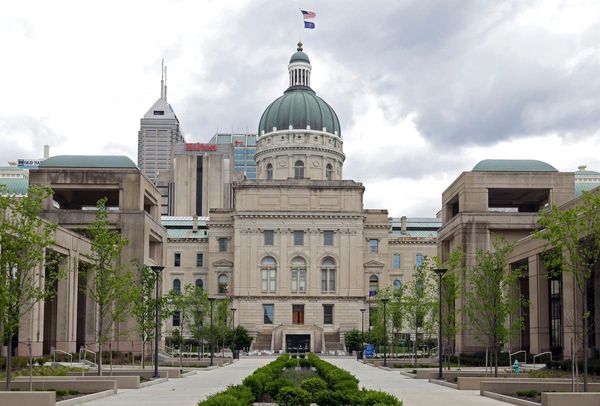
With two weeks to go, the polls suggest Labor is headed for a comfortable victory. No one believes it — least of all Labor. The possibility of minority government has been repeatedly raised in recent weeks.
That would make 2022 the third election in a row that voters have either voted in a minority government or delivered a narrow majority government. That’s what voters delivered in 2010, too. Only in 2007 and 2013 have voters delivered a convincing victory to one side. And, as independents like Monique Ryan like to point out, we’ve had a minority government for the last nine years courtesy of the Liberals being unable to govern with the extremists in the National Party.
What’s clearer is that, whether they win their seats or not, teal independents have seized a surprisingly large level of support in urban Liberal seats, and have supplanted Labor as the key opposition force against Liberal MPs.
The origins of the teals go back to a phenomenon first observed under John Howard. Back then, disgruntled Liberals in well-off seats were mocked, misogynistically, as “doctors’ wives”. That two of the key teal independents are doctors themselves is a nice kiss-off to that grubby, sexist slur.
Scott Morrison doesn’t dare go near any of these seats, The Liberal PM is deeply toxic in the Liberal heartland and would be the kiss of death for self-described “moderate” MPs trying to save their seats.
How did it come to this? Morrison’s involuntary smirking, relentless lying and glib vacuousness alienate many, but the toxicity is because of issues, not personality — particularly climate change. Morrison is far more comfortable in outer suburban seats and regional areas where he can talk about the economy and promise more coal mining and gas fracking jobs.
In 2019, there was evidence of real polarisation in Australia. In Victoria, Labor secured nearly 37% of the primary vote, and 52% in two party preferred terms. In Queensland, it only managed just under 27%, and only managed 41.6% 2PP. In WA, Labor couldn’t manage a 30% primary vote.
That’s polarisation.
Labor will lift its vote in WA this time, and looks likely to improve its performance in Queensland too — though perhaps not enough to gain seats. But the polarisation is spreading from geographical and state-based to urban-regional. As Labor has discovered, so too the Liberals: it’s now very hard to say one thing to regional communities and another to urban communities. For every assurance from a Dave Sharma or a Trent Zimmerman that they support climate action, there’s Matt Canavan to declare that net zero is dead and it’s time for more coal-fired power stations.
And as both Labor and the independents like to point out, a vote for the likes of Sharma, Zimmerman, Falinski, Wilson and, most especially, Frydenberg is a vote for Barnaby Joyce, an outright climate denialist, to be deputy prime minister.
The initial response by Liberal incumbents to the teal threat was to ostentatiously show that they were true moderates who had a real voice in a government run by right-wingers and denialists. More recently — encouraged by News Corp — the party has shifted to full-on, hysterical attacks. This week Scott Morrison was essentially suggesting the apocalypse would arrive if independents held the balance of power.
Meanwhile, Alexander Downer and former Victorian premier Ted Baillieu have written extraordinarily misogynist pieces about the independents — Baillieu refused to mention any of them by name, referencing only Simon Holmes à Court as their puppetmaster. Today a former Liberal hack argued in The Australian Financial Review that voters in urban Liberal seats should basically shut up and enjoy their privilege.
The rage of the federal Liberals is palpable — how dare once rusted-on voters abandon them over an issue as trivial as climate inaction? While state Liberals like Matt Kean have expertly used climate as a policy positive, his federal counterparts are wedded to denialists who refuse to acknowledge the laws of physics.
But polarisation is here to stay. It’s been growing across the Western world, fueled by growing inequality, globalisation, the loss of privilege of white heterosexual males, and the fragmentation of media and the growth of far-right, anti-democratic media like News Corp. In Australia it’s been masked by compulsory voting, but the same factors are at play.
Morrison himself, like Trump in the US, has sought to benefit from polarisation and deliberately fostered division. That’s his strategy with the odious Katherine Deves, with candidates who might have posed a real threat to Zali Steggall in Warringah kept out of the fray. Instead Deves serves as a dogwhistle to reactionaries and transphobes elsewhere.
Morrison can thus have no complaints if the division he has fostered starts breaking away urban Liberal seats at the federal level, further polarising a national electorate between those who want climate action yesterday — and who can afford to pay for it — and those for whom it’s a second-order issue, or who actively want more fossil fuels to be dug up and burnt.
While the federal Liberals remain shackled to the Nationals and ignore the need to bring regions and cities together, the polarisation will continue. Get used to teal — they won’t be one-election wonders. Certainly not if Morrison stays in power.






